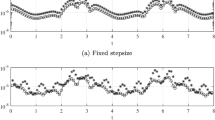Abstract
This paper extends previous studies of the application of Legendre spectral methods to the grad (div) eigenvalue problem on a quadrangular domain in \(I\!\!R^2\). The extension focuses on natural boundary conditions. Spectral approximations based on primal and dual variational approaches are built using Gaussian quadrature rules both on single (i.e. \(I\!\!P_N \otimes I\!\!P_N\)) and staggered (i.e. \(I\!\!P_N \otimes I\!\!P_{N-1}\)) grids. The single grid approximation is unstable and exhibits ‘spectral pollution’ effects such as increased number of zero eigenvalues and increased multiplicity of some non-zero eigenvalues. The approximation on the staggered grid leads to a stable algorithm, free of spurious eigenmodes and with spectral convergence of the non-zero eigenvalues/eigenvectors towards their analytical values.
Similar content being viewed by others
References
Ahusborde E., Azaïez M., Deville M.O., Mund E.H.: Legendre spectral methods for the -grad (div) operator. Comput. Methods Appl. Mech. Eng. 196, 4538–4547 (2007)
Azaïez M., Bernardi C., Grundmann M.: Spectral method applied to porous media. East–West J. Numer. Math. 2, 91–105 (1994)
Azaïez M., Deville M.O., Gruber R., Mund E.H.: On a stable spectral element for the grad (div) eigenvalue problem. J. Sci. Comput. 27, 41–50 (2006)
Bernardi C., Maday Y.: Spectral Methods. In: Ciarlet, P.G., Lions, J.L. (eds.) Handbook of Numerical Analysis, vol. V, pp. 209–485. North-Holland, Amsterdam (1997)
Bernardi C., Maday Y., Métivet B.: Spectral approximation of the periodic-nonperiodic Navier–Stokes equations. Numer. Math. 51, 655–700 (1987)
Boffi D, Costabel M., Dauge M., Demkowickz L.: Discrete compactness for the hp version of rectangular edge finite elements. SIAM J. Numer. Anal. 44(3), 979–1004 (2006)
Costabel M., Dauge M.: Computation of resonance frequencies for Maxwell equations in non smooth domains. In: Lecture Notes in Computational Science and Engineering, vol. 31. Springer (2003)
Davis P.J., Rabinowitz P.: Methods of Numerical integration. Academic Press, New York (1975)
Deville M.O., Fischer P.F., Mund E.H.: High-Order Methods for Incompressible Fluid Flow. Cambridge University Press, Cambridge (2002)
Galbrun H.: Propagation d’une Onde Sonore Dans l’atmosphère Terrestre et Théorie Des Zones de Silence. Gauthier-Villars, Paris, France (1931)
Olshanskii, M.A., Reusken, A.: Grad-div stabilisation for stokes equations. Math. Comput. 73(248), 1699–1718 (2003)
Monk, P., Wang, Y., Szabo, B.: Computing cavity models using the p-version of the finite element method. IEEE Trans. Magn. 32, 1934–1940 (1996)
Peyret, R.: Spectral Methods for Incompressible Viscous Flow. Springer, New York (2002)
Raviart, P.A., Thomas, J.M.: A mixed finite element method for second order elliptic problems. In: Mathematical Aspects of Finite Element Methods. Lecture Notes in Mathematics, vol. 606, pp. 292–315. Spriger-Verlag (1977)
Author information
Authors and Affiliations
Corresponding author
Rights and permissions
About this article
Cite this article
Ahusborde, E. Legendre spectral methods for the -grad (div) operator with free boundary conditions. Numer Algor 52, 151–171 (2009). https://doi.org/10.1007/s11075-008-9262-z
Received:
Accepted:
Published:
Issue Date:
DOI: https://doi.org/10.1007/s11075-008-9262-z




